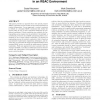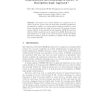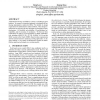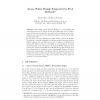MMMACNS
2001
Springer
14 years 5 months ago
2001
Springer
Abstract. In the past five years there has been tremendous activity in rolebased access control (RBAC) models. Consensus has been achieved on a standard core RBAC model that is in ...
SACMAT
2003
ACM
14 years 6 months ago
2003
ACM
Role-based Access Control (RBAC) models have been implemented not only in self-contained resource management products such as DBMSs and Operating Systems but also in a class of pr...
SACMAT
2003
ACM
14 years 6 months ago
2003
ACM
This paper presents an approach that uses special purpose RBAC constraints to base certain access control decisions on context information. In our approach a context constraint is...
ICTAC
2005
Springer
14 years 6 months ago
2005
Springer
Abstract. Role-based access control (RBAC) is recognized as an excellent model for access control in large-scale networked applications. Formalization of RBAC in a logical approach...
CCS
2007
ACM
14 years 7 months ago
2007
ACM
In this paper, we study the maintenance of role-based access control (RBAC) models in database environments using transitive closure relations. In particular, the algorithms that ...
CCS
2007
ACM
14 years 7 months ago
2007
ACM
Administration of large-scale RBAC systems is a challenging open problem. We propose a principled approach in designing and analyzing administrative models for RBAC. We identify s...
IRI
2007
IEEE
14 years 7 months ago
2007
IEEE
Recently, administration of RBAC systems using rolebased approach has become very appealing because of the benefits that a role-based approach typically brings. This approach uses...
IEEEIAS
2007
IEEE
14 years 7 months ago
2007
IEEE
Recently, administration of RBAC systems using a role-based approach has become very appealing because of the benefits that such an approach typically brings. This approach uses R...
SACMAT
2009
ACM
14 years 7 months ago
2009
ACM
XACML does not natively support RBAC and even the specialized XACML profiles are not able to support many relevant constraints such as static and dynamic separation of duty. Exte...
ICCS
2009
Springer
14 years 8 months ago
2009
Springer
Role Based Access Control (RBAC) is a methodology for providing users in an IT system specific permissions like write or read to t abstracts from specific users and binds permiss...




